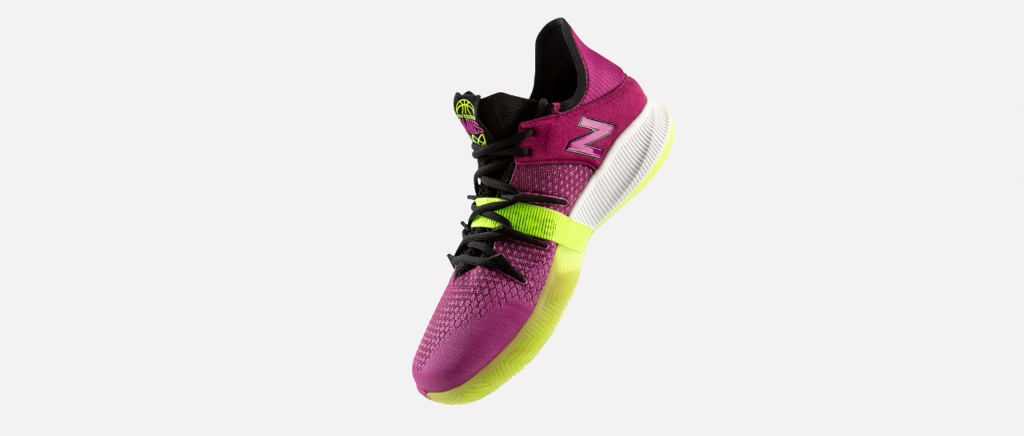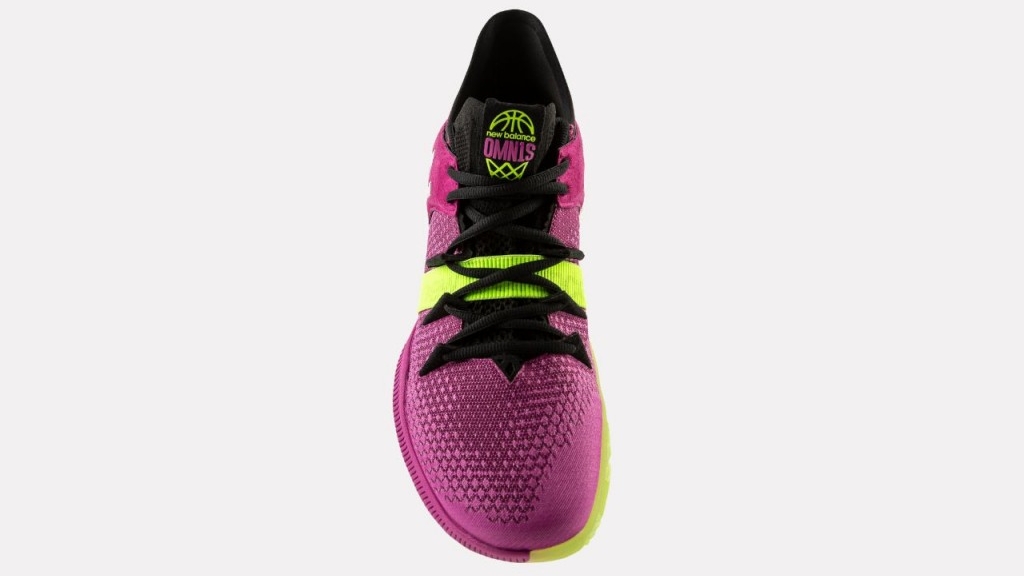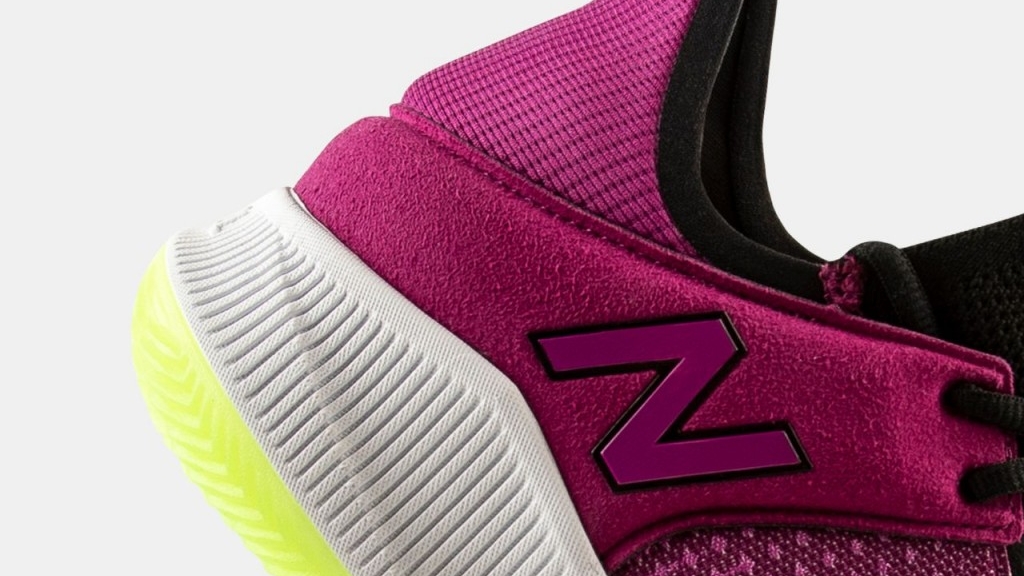
When New Balance decided to re-enter the basketball space in 2018 with the signing of top prospect Darius Bazley as an intern out of high school and landing Kawhi Leonard as the face of the brand, there were plenty of skeptics as to whether they could make a splash in the crowded hoops sneaker market.
Their first step back into the hoops arena, the OMN1S, ended up being a major hit as one of the best-reviewed performance basketball sneakers and developed a devoted following, something that was helped by a successful marketing campaign around their “Fun Guy.” Leonard has moved on to his own signature sneaker with the brand, but the OMN1S remains their flagship model and the line is finally evolving from a mid-top to a low, with a wide release slated for July 30 on NewBalance.com with a Berry Lime colorway.
The impetus behind the low-top version of the OMN1S is Bazley, who like many perimeter players prefers a low-profile sneaker that allows a bit more flexibility and lightness to their game. For Jonathan Grondin, the design director for New Balance basketball, the process of creating a high-performing low-top sneaker from a mid has been a long process, but one in which they believe they’ve succeeded.
Grondin has been hearing from fans since the launch of the OMN1S about a low-top version, but as he notes, taking a mid and turning it into a low is a far more technical process than just lopping an inch or two off the top.
“The process started with just consumers,” Grondin told Dime. “Darius Bazley, most specifically, he preferred a low from the first time he tried on our shoe, so we worked with him to kinda lower it, per se, but I think it was the conversation with the Instagram people where, turning a mid into a low isn’t as easy as just cutting off the top. I reflected on my experience doing baseball for 5-7 years, where every shoe we do we do in both versions, but you do that planning for it. And it’s such an art. Sometimes you just have to smush it, the whole thing down, to make the proportions work. Sometimes it’s just cut and adjust, and in this case the fit was so good in the OMN1S, we were so afraid we were going to lose it going to a low so we really focused on that.”

Given the rave reviews of the traction and fit of the OMN1S, Grondin’s first task was figuring out how to replicate that in a low. Happily for him, there wasn’t any adjustment needed for the sole, and the FitWeave upper was easily transitioned to a low-top to keep that same snug fit in the forefoot. As he said, “Fortunately we were able to keep the lower two-thirds of the shoe, basically as is, once we got the proportions visually to work.”
The big task was adapting that upper third, from moving the strap that’s at the top of the OMN1S mid to the custom sock that locks in the top of the foot, and, most importantly, the heel, which is molded with a ridge that helps lock the heel of the foot into the shoe.
“The hardest part is the 3D Adapt Ultra Heel, where our fit comes from fully being able to engineer exactly every millimeter of the inside and outside of this component, and just chopping that off or trying to shrink it wasn’t easy,” Grondin says. “So, like, we really tried to hold this [pointing to the heel of the OMN1S mid], there’s a ridge inside here where when your heel goes in the shoe it feels like a ball and socket. Like, your foot just snaps into it in a weird way. The interface with the shoe is next level for us, and the challenge was how do we duplicate that in a low. So we tried to hold the internals exactly as is while adjusting everything else and we successfully did it, but that was the biggest challenge was trying to match that heel fit and not sacrifice the great reviews the shoe’s been getting.”
Bazley was a major impetus behind them beginning the process of creating a low-top version, but the testing of the shoe starts at the high school and college level for New Balance, long before they let it get to their NBA stars.
“I think he authenticated it and sort of validated it at the level of the NBA, but truthfully if we didn’t have all the people we had wear testing it prior, we wouldn’t have had the confidence to put it on Darius’ foot at that point,” Grondin says. “Like, we have to believe — when we first started basketball we did focus groups and we had wear testers, and all of a sudden once you get Kawhi, Darius, [Spurs guard] Dejounte [Murray] at this point, we feel like we have to be confident enough in the shoe before we even let them try it. But you see what happens when shoes explode at that level or when they fail or god forbid someone gets hurt. So, truthfully, at this point, they’re the final sign-off. They’re not part of the process of validating that fit until the end.”
The input from all levels of basketball is important for Grondin, as it’s not just a shoe that has to perform for NBA players. Since it’s a sneaker released to the public, it has to work for everyone. That means the cushioning has to be firm enough to handle the power of an NBA player, but soft enough that the casual player can still flex the shoe and not battle blisters. This leads to months of testing and feedback from their network of testers, then building on that with conversations with the players and many more in the NBA to dial in the performance aspect and make sure it’s going to allow their stars to be confident.
“We work with their team doctors. We work with their strength and conditioning coaches. We have meetings with the equipment guys for all these teams,” Grondin says. “The relationships we’ve formed with all these teams we have players on goes very deep. It’s not a hobby to any of these people. It’s big business, which I think was somewhat eye opening. I think we figured it’d be a little bit bigger than what we do with baseball and some of the running — not like, track and field — but it’s really particular. Which I appreciate, it’s why I got into design. The minutiae of making athletes better and being on the edge of performance is what I’m all about.”

From there it was a process of making the aesthetics of the low work. The logo, which lives high up on the OMN1S, had to be shifted, a process he said they spent months on, tweaking and rotating the logo by “millimeters” until they had it how they wanted it. Ultimately, they landed on a look that is unique to the low but still recognizable as an OMN1S, making it something that, as Grondin said, can work “wearing it out with sweats on a Chipotle run.”
New Balance’s return to the basketball space was a labor of love and months of work, and that same passion and effort is evident in hearing Grondin talk about the process of creating a low-top version of their popular debut line.
